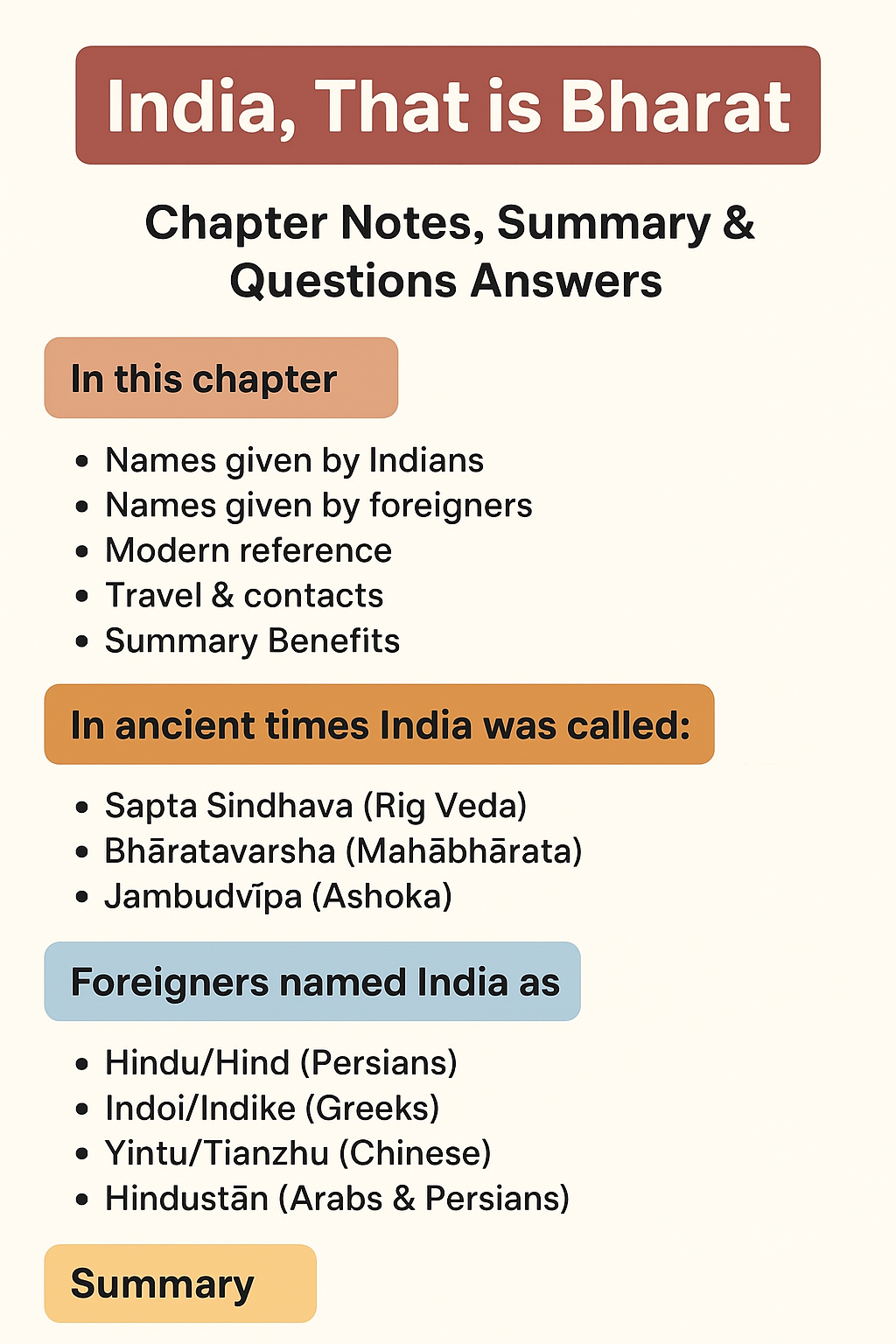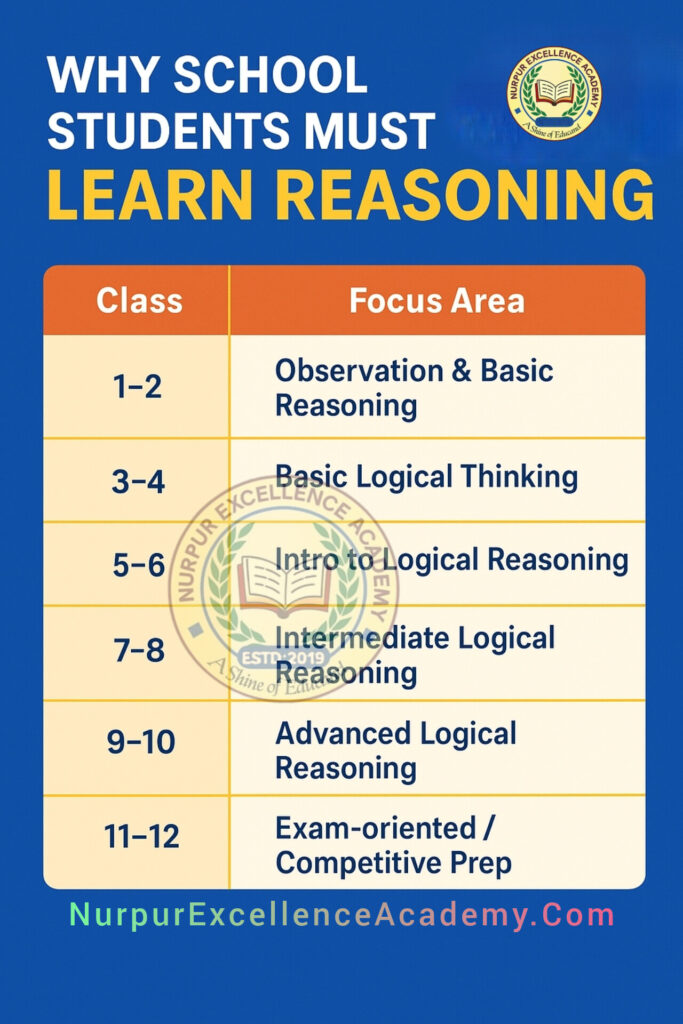India, That is Bharat : NCERT Class 6 History Chapter 5
🌟 Chapter Summary
- India as a land:
India is one of the world’s oldest civilizations. From early times, people here shared a sense of spiritual and cultural unity. - Names given by Indians:
- Rig Veda (Sapta Sindhava): “Land of seven rivers.”
- Mahābhārata: Mentions regions (Kashmir, Bengal, Kerala, etc.); uses Bhāratavarṣha (land of Bharatas) and Jambudvīpa (island of jamun fruit).
- Viṣhṇu Purāṇa: Describes India as land north of the ocean, south of the Himalayas.
- Tamil Literature: Mentions land from Cape Kumari (south) to Himalayas (north), between seas.
- Names given by foreigners:
- Persians: From “Sindhu” → Hindu/Hind.
- Greeks: Modified Hindu to Indoi/Indike.
- Chinese: Used Yintu/Yindu, also Tianzhu (heavenly master).
- Arabs & Persians (later): Hindustān.
- Europeans: India (English), Inde (French), etc.
- Modern reference:
- The Constitution of India (1950) begins with “India, that is Bharat.”
- Even today, the dual names Bharat and India are official.
- Travel & Contacts:
Foreigners like Xuanzang (7th CE) visited for religion, learning, and culture. India attracted traders, pilgrims, scholars, and invaders.
📝 Important Notes / Key Points
- Sapta Sindhava – earliest name (Rig Veda), meaning “land of seven rivers.”
- Bhāratavarṣha – land of Bharatas, widely used in Mahābhārata and Purāṇas.
- Jambudvīpa – means island of jamun tree fruit, used by Ashoka (250 BCE).
- Persians → Hindu/Hind; Greeks → Indoi/Indike; Chinese → Yintu/Tianzhu.
- Hindustān – first used in Persian inscription ~1800 years ago.
- Xuanzang – famous Chinese pilgrim, stayed 17 years in India.
- Indian Constitution (1950) – starts with “India, that is Bharat.”
- India always had many names due to diverse cultures and foreign contacts.
📝 Questions & Answers
Part A – MCQ
Q1. The Rig Veda refers to north-western India as –
👉 Answer: Sapta Sindhava
Q2. Which emperor used the word Jambudvīpa?
👉 Answer: Emperor Ashoka
Q3. The Viṣhṇu Purāṇa defines Bhārata as –
👉 Answer: Land between Himalayas and Ocean
Q4. The word Bhārata means –
👉 Answer: Land of the Bharatas
Q5. The Mahābhārata uses which two terms for India?
👉 Answer: Bhāratavarṣha and Jambudvīpa
Q6. Which text first mentioned Sapta Sindhava?
👉 Answer: Rig Veda
Q7. The Chinese word Tianzhu means –
👉 Answer: Heavenly master (respect for India as land of Buddha)
Q8. Who was Xuanzang?
👉 Answer: A Chinese pilgrim who visited India in 7th CE
Q9. The Greeks called India –
👉 Answer: Indoi / Indike
Q10. The Persians adapted the word Sindhu to –
👉 Answer: Hindu / Hind
Q11. The Tamil poem describes India from Cape Kumari to –
👉 Answer: The Himalayas
Q12. In the Constitution, India is described as –
👉 Answer: “India, that is Bharat.”
Q13. The term Hindustān was first used in –
👉 Answer: A Persian inscription
Q14. Jambudvīpa was mentioned in Ashoka’s inscriptions around –
👉 Answer: 250 BCE
Q15. The Latin name for India is –
👉 Answer: India
Part B – True/False
- The Rig Veda describes the whole of India. ❌
- The Mahābhārata mentions regions like Kashmir, Bengal, Kerala. ✅
- Bhārata means “the land of the Bharatas.” ✅
- Jambudvīpa literally means “the island of the mango tree.” ❌ (It’s the jamun tree)
- Ashoka used the word Jambudvīpa in his inscriptions. ✅
- The Viṣhṇu Purāṇa defines Bhārata as north of the ocean and south of Himalayas. ✅
- Persians first called India Hind. ✅
- Greeks used the name Indoi/Indike for India. ✅
- Chinese referred to India only as Yindu, never Tianzhu. ❌
- Xuanzang translated Sanskrit texts into Chinese. ✅
- Hindustān is first seen in Ashoka’s inscriptions. ❌
- “India, that is Bharat” is written in the Constitution of India. ✅
- In Persian, the word Hindu originally meant followers of Hindu religion. ❌
- Tamil literature described India’s boundaries in poetic form. ✅
- Bhārata was a name given by foreigners. ❌
Part C – Fill in the blanks
- The most ancient Indian text is __________.
👉 Rig Veda - Rig Veda refers to India as __________.
👉 Sapta Sindhava - Mahābhārata uses __________ and __________ for India.
👉 Bhāratavarṣha, Jambudvīpa - In Ashoka’s time, Jambudvīpa included India, __________, __________, and Afghanistan.
👉 Pakistan, Bangladesh - The Persians called India __________.
👉 Hindu / Hind - The Greeks called India __________ or __________.
👉 Indoi, Indike - Chinese texts called India __________ and __________.
👉 Yintu/Yindu, Tianzhu - The Constitution mentions “India, that is __________.”
👉 Bharat - The word Bhārata first appears in the __________.
👉 Rig Veda - Jambudvīpa means island of the __________ tree.
👉 Jamun - Tamil poem describes India from Cape Kumari to the __________ mountains.
👉 Himalayas - Xuanzang visited India in the __________ century CE.
👉 7th - The Latin word for India is __________.
👉 India - Hindustān was first mentioned in a __________ inscription.
👉 Persian - Viṣhṇu Purāṇa says Bhārata lies north of __________ and south of __________.
👉 The ocean, the Himalayas
Part D – Short Answer Questions
Q1. What does Sapta Sindhava mean?
👉 Land of seven rivers, mentioned in Rig Veda.
Q2. What is the significance of Bhārata in Indian tradition?
👉 Represents unity of the land, used widely in texts, still official name.
Q3. What does Jambudvīpa signify?
👉 Island of jamun tree fruit, refers to Indian Subcontinent.
Q4. How does the Viṣhṇu Purāṇa define Bhārata?
👉 Country north of ocean and south of Himalayas.
Q5. Who were the first foreigners to mention India, and what name did they use?
👉 Persians; they used Hind/Hindu.
Q6. How did Greeks change the name of India?
👉 From Persian Hindu → Indoi/Indike, dropping “h”.
Q7. Which names did the Chinese use for India?
👉 Yintu/Yindu and Tianzhu.
Q8. Who was Xuanzang and what did he do in India?
👉 A Chinese pilgrim-scholar, visited in 7th CE, studied Buddhism, carried manuscripts to China.
Q9. How is India described in the Tamil poem (2000 years ago)?
👉 From Cape Kumari in south to Himalayas in north, between eastern and western oceans.
Q10. What phrase is used in the Constitution to describe India?
👉 “India, that is Bharat.”
Part E – Long Answer Questions
Q1. Discuss the ancient indigenous names of India.
Answer:
India has been known by many names given by its own people since ancient times. In the Rig Veda, the north-western part of India was called Sapta Sindhava, which means “the land of seven rivers.” Later, in the Mahābhārata and the Purāṇas, the word Bhāratavarṣha was used. It means “the land of the Bharatas,” who were an important group of people in ancient India. Another important name was Jambudvīpa, which means “the island of the jamun fruit tree.” Even Emperor Ashoka used this name in his inscriptions around 250 BCE. Ancient Tamil literature also described India as the land stretching from Cape Kumari in the south to the Himalayas in the north, showing that Indians had a strong idea of their country’s unity.
Q2. Explain how foreigners named India (Persians, Greeks, Chinese, Arabs).
Answer:
Foreigners who came to India also gave it different names. The Persians were among the first. They used the word Hindu/Hind, which came from the river Sindhu (Indus). Later, the Greeks borrowed this name but changed it to Indoi or Indike, because their language did not have the letter “h.” The Chinese called India Yintu/Yindu (from Sindhu) and also used Tianzhu, which meant “heavenly master,” showing their respect for India as the land of the Buddha. Later on, the Arabs and Persians used the word Hindustān, which became a popular name for India in the medieval period. Finally, when Europeans like the Portuguese, French, and English came, they used the name India (English) and Inde (French).
Q3. How do ancient texts show unity of India’s geography?
Answer:
Ancient Indian texts clearly show that people already had an idea of India as one land. The Mahābhārata mentions many regions, like Kashmir, Kutch, Bengal, and Kerala, proving that people thought about the whole Subcontinent as one unit. The Viṣhṇu Purāṇa describes Bhārata as “the land that lies north of the ocean and south of the snowy mountains (Himalayas).” Similarly, in ancient Tamil poems, poets wrote that a king was famous from Cape Kumari in the south to the Himalayas in the north, and from the eastern sea to the western sea. All these examples show that Indians had a clear idea of their country’s unity and boundaries.
Q4. Why did India have many different names in history?
Answer:
India had many different names because it is a very old and diverse country. Its vast geography meant that different regions used different names. People spoke many languages and wrote many kinds of literature, so names varied. India also had rich cultural diversity, with many kingdoms and traditions, so the name changed according to context. Moreover, foreign visitors and traders gave new names based on their own languages (for example, Hind, Indoi, Yintu). Over thousands of years, India’s identity kept evolving, and that is why we find so many names like Sapta Sindhava, Bhāratavarṣha, Jambudvīpa, Hindustān, and India.
Q5. What were Ashoka’s contributions to the naming of India?
Answer:
Emperor Ashoka, who ruled around 250 BCE, was one of the greatest kings of ancient India. He left behind many inscriptions on pillars and rocks. In these inscriptions, he used the name Jambudvīpa to describe the whole Subcontinent. During Ashoka’s time, this land included modern-day India, Pakistan, Bangladesh, and parts of Afghanistan. This shows that Ashoka thought of the region as one large and united country. His use of the name Jambudvīpa is an important contribution to how India was understood and remembered in history.
Q6. Why did foreigners travel to India in ancient times?
Answer:
Foreigners traveled to India for many reasons:
- Trade and Commerce: India was rich in spices, silk, cotton, precious stones, and other goods. Traders from Persia, Arabia, and Europe came to buy and sell these items.
- Religion and Pilgrimage: Many people came to learn about Buddhism and visit holy sites. Chinese monks like Xuanzang came to study Indian scriptures.
- Education: India had famous universities like Nalanda and Takshashila, which attracted students from different countries.
- Conquests and Power: Some foreigners, like the Persians and Greeks, came to conquer and control land.
- Curiosity and Culture: Many visitors came to learn about India’s knowledge, traditions, and way of life.
Thus, India was a land of attraction for many people from across the world.
Q7. How is the name Bhārata reflected in modern India?
Answer:
The name Bhārata is still very important in modern India. It is officially mentioned in the Constitution of India (1950), which begins with the words “India, that is Bharat.” This shows that both names are official. In the Hindi version of the Constitution, it says “Bhārat arthāth India.” Today, the word Bharat is used in almost all Indian languages, in schools, government documents, and even in sports (e.g., “Team Bharat”). The name Bhārata is not just a name; it represents the unity, culture, and identity of India that has continued for thousands of years.
Q8. Write a note on Xuanzang’s visit to India.
Answer:
Xuanzang was a famous Chinese Buddhist monk and scholar who came to India in the 7th century CE. He travelled across India for about 17 years, visiting many kingdoms and holy Buddhist sites. He studied at the great Nalanda University, where he learned Buddhist philosophy and collected many manuscripts. After returning to China, Xuanzang translated the Sanskrit texts he had brought into Chinese. His work spread Indian knowledge and Buddhism widely in China. His detailed travel records also give us valuable information about India’s society, politics, and culture during that period. Xuanzang’s journey is an important link between India and China in history.

✍️ Conclusion
India, that is Bharat, is not just a country with one name but a civilization with many identities. From Sapta Sindhava and Bhāratavarṣha to Jambudvīpa, Hindustān, and India, each name tells a story of culture, history, and unity. Understanding these names helps students connect with India’s glorious past and see how its heritage continues to shape the present.



Leave a Reply